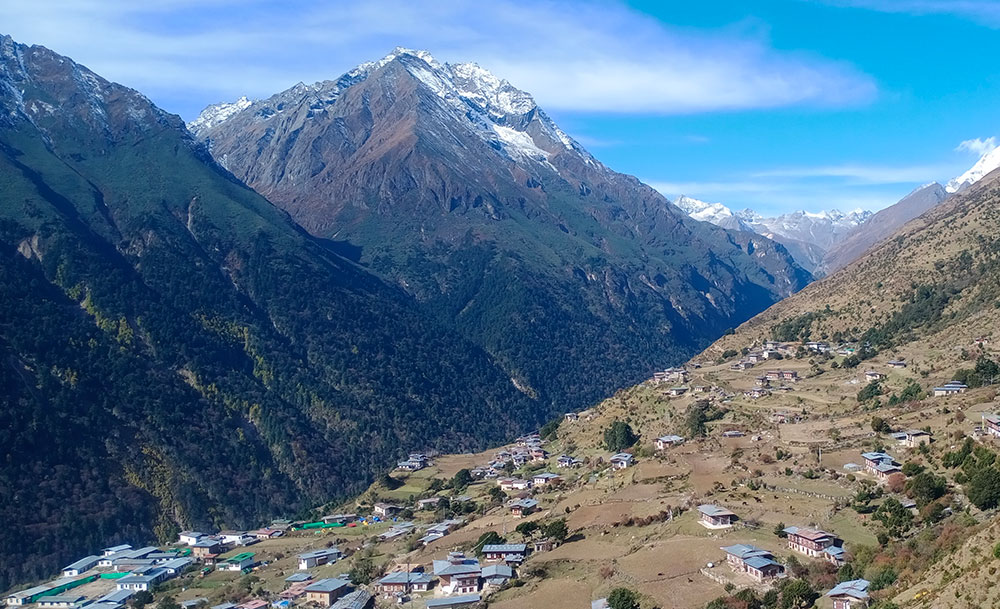Yangyel Lhaden
The road winds its way, a serpentine ribbon, until it reaches Tongchudrak. From here, the path ahead diverges from the comforts of vehicular transport, and you embark on a memorable five-hour trek to the enchanting Laya village.
The journey from Gasa to Tongchudrak is nothing short of nerve-wracking. Along the way, you’ll encounter narrow roads that cling precariously to the mountainside, with steep cliffs plummeting into the abyss below. As you navigate these challenging passages, every oncoming car tests the skills of the driver in an exhilarating display of manoeuvering.
Only the most robust and sizeable vehicles can ply this rugged terrain. The road, once a distant dream, is slowly inching closer to Laya with each passing year. The road from Gasa to Laya initially reached Ponjothang, then Koina, and now it stretches all the way to Tongchudrak. The plan is to extend it further to Taktse Makha within the next six months. From there, only a two-hour uphill trek separates intrepid travellers from the mystical Laya, shrouded in the mist of legend.
But for now, let us shift our gaze back to Tongchudrak, the gateway to this incredible journey through Laya’s breathtaking landscapes.
As you approach, a lush hill named Tongchudrak rises on one side of the path, a muddy road winding its way through the middle. On the other side, the pristine Mochhu glistens like a gem with its waters bearing a greenish hue, a sight to behold.
In preparation for the hike to witness the Royal Highland Festival in Laya, people load their horses with supplies, while vehicles arrive to find their temporary resting place. A herd of horses, adorned with tinkling bells, marches towards the base, their rhythmic sound a symphony of the highlands. It’s a bustling scene, filled with anticipation and excitement.
Tongchudrak is more than just a name; it is a cliff with a history. In the past, travellers had to either ascend the hill and descend on the other side or cross the Mochhu, an option available only during the winter.
As you set foot on the path, nature’s brush paints an autumn tableau. Leaves in shades of orange, yellow, and green create a picturesque landscape. Hikers and horses share the trail, with hikers often yielding to the horses. A word of caution: give way to the horses on the right, as those carrying heavy loads could nudge you toward the cliff if you stand on the left.
The trail to Taktse Makha, a three-hour journey, is relatively gentle, with no arduous climbs. While the path can be quite muddy, if you’re lucky enough to hike on a dry day, it’s manageable. At Taktse Makha, hikers pause for a rejuvenating break, sipping on tea and enjoying snacks in a cozy tented restaurant.
It’s not the path that takes its toll, but the altitude. As you ascend, the air becomes thinner, and each breath feels like a challenge. Your nostrils tingle with the brisk mountain air. A simple ascent seems arduous the higher you go, but I had my trusty Fisherman mint tablet that offered some relief.
Locals have their own remedies for altitude sickness – some rely on garlic, others on paracetamol, and a few indulge in the comforting embrace of chocolates. Whichever remedy you choose, it’s all part of the experience.
Hikers have made thoughtful arrangements for their journey, booking homestays and porter services through gewog and dzongkhag administration offices or tour agents, while some have relied on personal connections. Everyone is eager to experience the wonders that Laya has to offer.
As you continue your ascent, Laya draws near. Just two more hours of hiking, and you’ll reach your destination. The path becomes steeper, and the village of Laya remains hidden from view until you reach the first village, Tongra.
In the words of Dorji Dhratyul, as described in his book Hercules of Tongchudrak, Laya is nothing short of “heaven on earth.” Locals regard it as a “beyul,” a hidden land which is not visible until you step into the realm of Laya or approach from the sky.
After a challenging uphill climb, you are greeted by a breathtaking panorama of snowcapped peaks, a traditional Bhutanese village that seems plucked from a fairy tale, and the crisp, invigorating mountain air that beckons you.
Welcome to Laya, a place of wonder and enchantment, where nature’s beauty knows no bounds.
The coverage is supported by Department of Tourism


